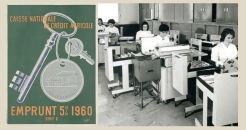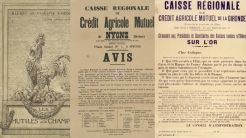
Crédit Agricole 140 years of history : 1920s - Electricity and housing
The birth of the Caisse Nationale de Crédit Agricole
With the end of the war, Crédit Agricole improved its operations. In 1920, it decided to replace the government advances distribution committee with a public entity. This led to the creation of the Office National du Crédit Agricole, renamed Caisse Nationale de Crédit Agricole in 1926. This was a unique set-up, with a public entity acting as the central institution for private cooperative entities – the regional banks. State control over the Caisse Nationale allowed it to guide major decisions on agricultural investment.
Extension of the scope of action
It was also at this time of relaunching farming that subsidised loans distributed by Crédit Agricole were put in place, allowing farmers to borrow at a preferential rate, with the government paying the difference. This product boosted Crédit Agricole’s growth. The regional banks also recorded an increase in the number of deposit accounts opened during this period.
In 1923, the government authorised Crédit Agricole to finance rural municipalities for their electrification. This was a real success. A large number of villages could thus access electricity and, again, this helped combat the rural exodus.
Finally, from 1928, the regional banks were able to grant low-interest loans to farm workers and small tradesmen of limited means for the construction or purchase of a home or for its enhancement and sanitation. This new extension of Crédit Agricole’s scope of action was enthusiastically welcomed by the regional banks, which saw this as a way of improving living conditions in rural areas.
In the same Series
-
 Crédit Agricole 140 years of history: 2025 until todayCrédit Agricole is now an original model of universal retail banking.
Crédit Agricole 140 years of history: 2025 until todayCrédit Agricole is now an original model of universal retail banking. -
 Crédit Agricole 140 years of history: 2010s - The expression of our “Raison d’être”At the beginning of this decade, Crédit Agricole: included 39 regional banks, fully-fledged banks and the majority shareholders of the central institution Crédit Agricole S.A.; was active in all banking businesses; provided services to all types of customers, from individuals to corporates and institutional investors, from the most vulnerable to the wealthiest; included a second retail banking network, LCL; was present throughout France and on all continents.
Crédit Agricole 140 years of history: 2010s - The expression of our “Raison d’être”At the beginning of this decade, Crédit Agricole: included 39 regional banks, fully-fledged banks and the majority shareholders of the central institution Crédit Agricole S.A.; was active in all banking businesses; provided services to all types of customers, from individuals to corporates and institutional investors, from the most vulnerable to the wealthiest; included a second retail banking network, LCL; was present throughout France and on all continents. -
 Crédit Agricole 140 years of history: 2000s - A new dimensionIn 2001, the regional banks, the majority shareholders of Caisse Nationale de Crédit Agricole, decided to open up its capital to the public.
Crédit Agricole 140 years of history: 2000s - A new dimensionIn 2001, the regional banks, the majority shareholders of Caisse Nationale de Crédit Agricole, decided to open up its capital to the public. -
 Crédit Agricole 140 years of history: 1990s - A growing groupCrédit Agricole, no longer under government supervision, was now in control of its destiny. It completed its goal of becoming a universal bank with the ambition of being useful to all.
Crédit Agricole 140 years of history: 1990s - A growing groupCrédit Agricole, no longer under government supervision, was now in control of its destiny. It completed its goal of becoming a universal bank with the ambition of being useful to all. -
 Crédit Agricole 140 years of history: 1980s - The beginnings of universal bankingIn the early 1980s, Crédit Agricole operated throughout France, including in the largest urban areas. It also began to develop its international network with a growing number of new locations (Frankfurt, Milan, Cairo, Singapore, etc.).
Crédit Agricole 140 years of history: 1980s - The beginnings of universal bankingIn the early 1980s, Crédit Agricole operated throughout France, including in the largest urban areas. It also began to develop its international network with a growing number of new locations (Frankfurt, Milan, Cairo, Singapore, etc.). -
 Crédit Agricole 140 years of history: 1970s - From rural to internationalFrom 1971, Crédit Agricole’s geographical scope gradually expanded.
Crédit Agricole 140 years of history: 1970s - From rural to internationalFrom 1971, Crédit Agricole’s geographical scope gradually expanded. -
 Crédit Agricole 140 years of history: 1960s - A decade of renewalSince 1897, Crédit Agricole received advances from the government each year, which it had to repay.
Crédit Agricole 140 years of history: 1960s - A decade of renewalSince 1897, Crédit Agricole received advances from the government each year, which it had to repay. -
 Crédit Agricole 140 years of history: 1950s - Expansion of the networkIn the early 1950s, Crédit Agricole developed savings inflows to boost financing for French farmers.
Crédit Agricole 140 years of history: 1950s - Expansion of the networkIn the early 1950s, Crédit Agricole developed savings inflows to boost financing for French farmers. -
 Crédit Agricole 140 years of history: 1940s - War and reconstructionThe Second World War disrupted the organisation of Crédit Agricole.
Crédit Agricole 140 years of history: 1940s - War and reconstructionThe Second World War disrupted the organisation of Crédit Agricole. -
 Crédit Agricole 140 years of history : 1930s - Helping farmers through the crisisThe 1929 crisis that began in the United States reached France in the following years.
Crédit Agricole 140 years of history : 1930s - Helping farmers through the crisisThe 1929 crisis that began in the United States reached France in the following years. -
 Crédit Agricole 140 years of history : 1910s - Serving the entire countryAt this time, two important measures strengthened Crédit Agricole’s action in its fight against rural depopulation.
Crédit Agricole 140 years of history : 1910s - Serving the entire countryAt this time, two important measures strengthened Crédit Agricole’s action in its fight against rural depopulation. -
 Crédit Agricole 140 years of history : 1900s - First extension of the scope of actionThe first decade of the 20th century saw Crédit Agricole establish a lasting presence in the regions.
Crédit Agricole 140 years of history : 1900s - First extension of the scope of actionThe first decade of the 20th century saw Crédit Agricole establish a lasting presence in the regions. -
 Crédit Agricole 140 years of history : 1890s - A bottom-up organisationCreation of the local banks
Crédit Agricole 140 years of history : 1890s - A bottom-up organisationCreation of the local banks -
 Crédit Agricole 140 years of history : 1880s - Creation in the JuraOur story begins in 1885 in Salins-les-Bains in the Jura.
Crédit Agricole 140 years of history : 1880s - Creation in the JuraOur story begins in 1885 in Salins-les-Bains in the Jura.









